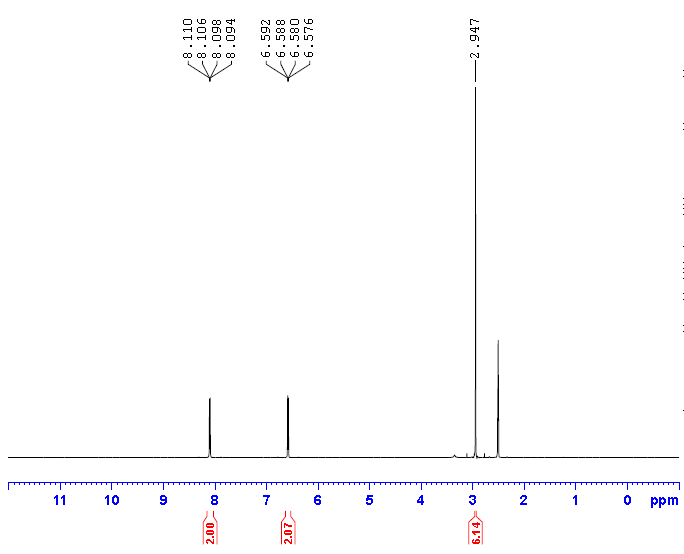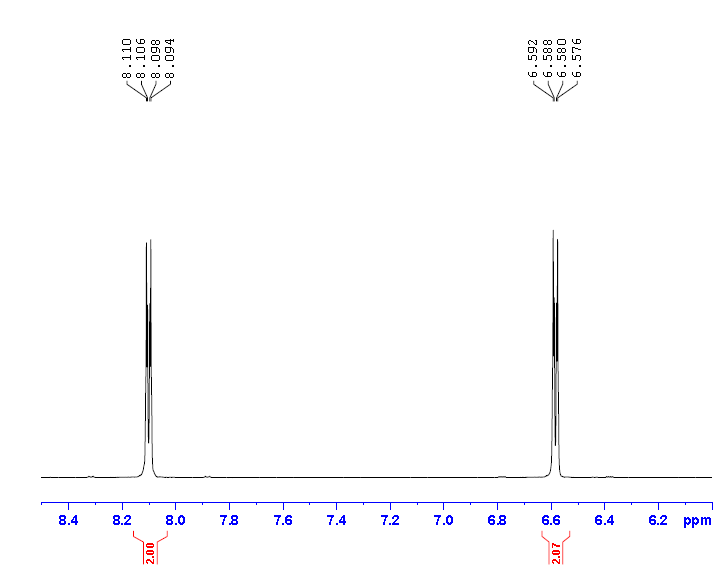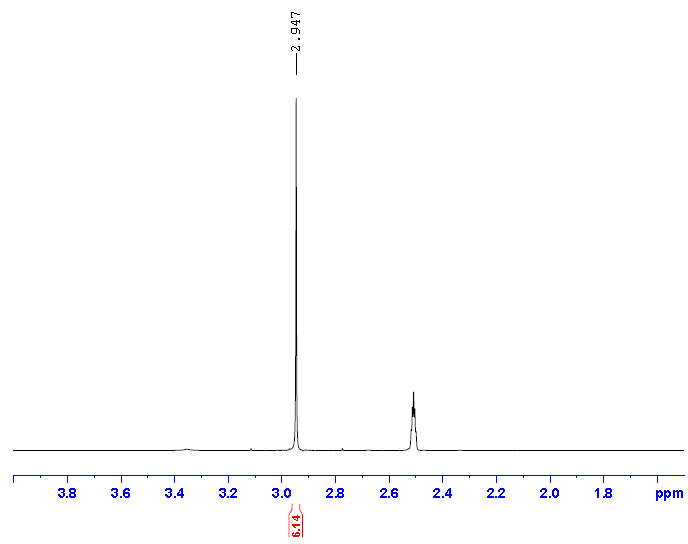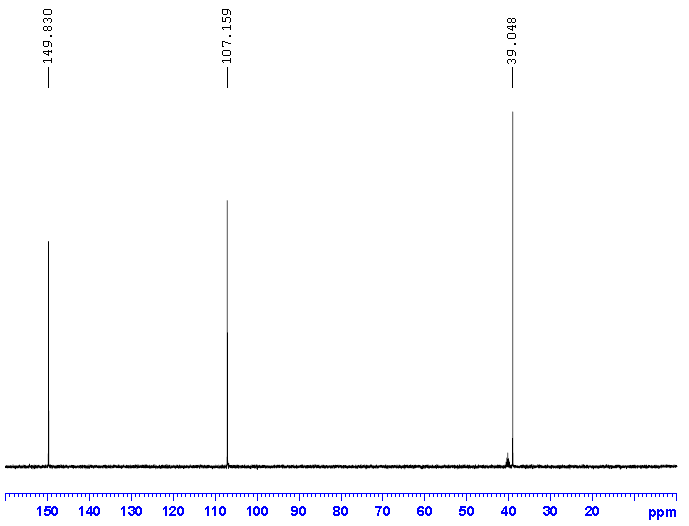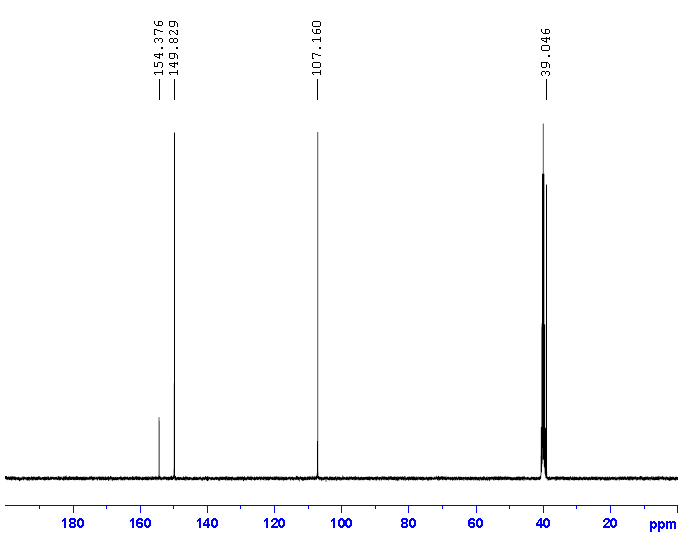4-Dimethylaminopyridine CAS#: 1122-58-3; ChemWhat Code: 8209
Identification
| Product Name | 4-Dimethylaminopyridine |
| IUPAC Name | N,N-dimethylpyridin-4-amine |
| Molecular Structure | 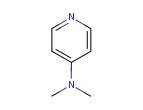 |
| CAS Registry Number | 1122-58-3 |
| EINECS Number | 214-353-5 |
| MDL Number | MFCD00006418 |
| Beilstein Registry Number | 110354 |
| Synonyms | dmap4-dimethylaminopyridin |
| Molecular Formula | C7H10N2 |
| Molecular Weight | 122.17 |
| InChI | InChI=1S/C7H10N2/c1-9(2)7-3-5-8-6-4-7/h3-6H,1-2H3 |
| InChI Key | VHYFNPMBLIVWCW-UHFFFAOYSA-N |
| Canonical SMILES | CN(C)c1ccncc1 |
| Patent Information | ||
| Patent ID | Title | Publication Date |
| WO2022/6427 | MANUFACTURING PROCESS FOR 3,5-DICHLOROPICOLINONITRILE FOR SYNTHESIS OF VADADUSTAT | 2022 |
| US2020/62752 | NOVEL PYRIDONE CARBOXYLIC ACID DERIVATIVE OR SALT THEREOF | 2020 |
| CN111217726 | Paeonol ester derivative, and preparation method and application thereof | 2020 |
Physical Data
| Appearance | White Solid |
| Solubility | ACN:H2O (8:2) |
| Flash Point | 124 °C |
| Melting Point, °C | Solvent (Melting Point) |
| 108 – 110 | |
| 117.64 | |
| 109 – 111 | |
| 113.934 | ethanol |
| Boiling Point, °C | Pressure (Boiling Point), Torr |
| 190 | 150 |
| Description (Association (MCS)) | Solvent (Association (MCS)) | Temperature (Association (MCS)), °C | Partner (Association (MCS)) |
| Stability constant of the complex with … | CCl4 | 24.9 | 4-Fluorophenol |
| Stability constant of the complex with … | aq. HNO3 | 25 | AgNO3 |
| Enthalpy of association | acetonitrile | 25 | iodine |
| NMR spectrum of the complex | CDCl3 | Cu(2,4-dichloro-benzoate)2 |
Spectra
| Description (NMR Spectroscopy) | Nucleus (NMR Spectroscopy) | Solvents (NMR Spectroscopy) | Temperature (NMR Spectroscopy), °C | Frequency (NMR Spectroscopy), MHz |
| Spectrum | 1H | |||
| Chemical shifts | 1H | dimethylsulfoxide-d6 | ||
| Chemical shifts | 1H | dichloromethane-d2 | 25 | 300.1 |
| Chemical shifts, Spectrum | 1H | water-d2 | 26.84 | 400 |
| Chemical shifts, Spectrum | 13C | chloroform-d1 | 151 |
| Description (IR Spectroscopy) | Solvent (IR Spectroscopy) | Temperature (IR Spectroscopy), °C |
| Bands, Spectrum | potassium bromide | |
| ATR (attenuated total reflectance), Intensity of IR bands, Bands | 25 | |
| Bands | potassium bromide | |
| Intensity of IR bands, ATR (attenuated total reflectance), Bands, Spectrum | ||
| Intensity of IR bands, Bands, Spectrum | potassium bromide |
| Description (Mass Spectrometry) |
| high resolution mass spectrometry (HRMS), electrospray ionisation (ESI), time-of-flight mass spectra (TOFMS), spectrum |
| spectrum |
| high resolution mass spectrometry (HRMS), electrospray ionisation (ESI), spectrum |
| high resolution mass spectrometry (HRMS), spectrum |
| liquid chromatography mass spectrometry (LCMS), spectrum |
| CI (Chemical ionization), Spectrum |
| 4-Dimethylaminopyridine CAS#: 1122-58-3 MS | 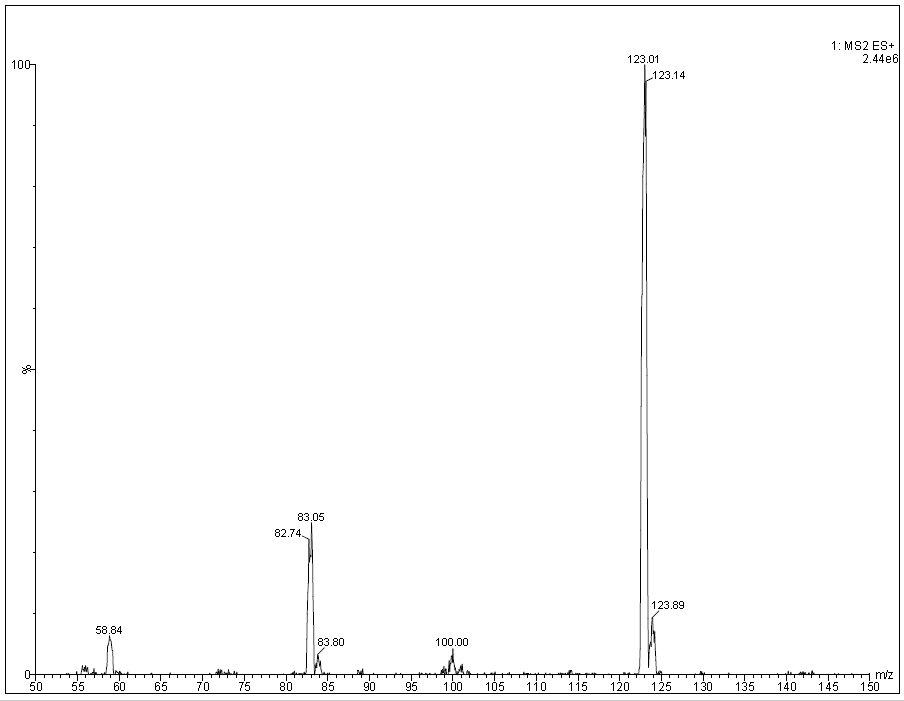 |
| Description (UV/VIS Spectroscopy) | Solvent (UV/VIS Spectroscopy) | Absorption Maxima (UV/VIS), nm | Ext./Abs. Coefficient, l·mol-1cm-1 |
| acetonitrile | 256 | 20310 | |
| Spectrum | aq. buffer | ||
| Spectrum | water monomer | ||
| Spectrum | N,N-dimethyl-formamide | ||
| Reflection spectrum, Spectrum | |||
| Spectrum | dichloromethane | 258 |
| 4-Dimethylaminopyridine CAS#: 1122-58-3 UV | 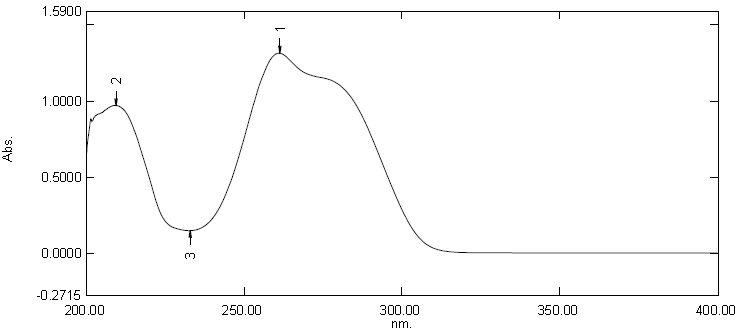 |
Route of Synthesis (ROS)
| Conditions | Yield |
| Stage #1: pyridine-4-carbonitrile With hydrogenchloride; acrylic acid at 90℃; for 1.5h; Inert atmosphere; Stage #2: dimethyl amine at 70℃; for 2.5h; Inert atmosphere; Stage #3: With sodium hydroxide at 70 – 90℃; for 3.5h; Temperature; Reagent/catalyst; Inert atmosphere; | 99.4% |
| Stage #1: pyridine-4-carbonitrile With hydrogenchloride; acrylic acid In water at 70℃; for 4h; Inert atmosphere; Stage #2: dimethyl amine In water at 50℃; for 3h; Temperature; Inert atmosphere; | 99% |
| Stage #1: pyridine-4-carbonitrile With hydrogenchloride; hydroquinone; acrylic acid In water at 90℃; for 6h; Stage #2: dimethyl amine In water for 3h; Temperature; Reflux; | 98.6% |
Safety and Hazards
| Pictogram(s) |      |
| Signal | Danger |
| GHS Hazard Statements | H301 (100%): Toxic if swallowed [Danger Acute toxicity, oral] H310 (76.41%): Fatal in contact with skin [Danger Acute toxicity, dermal] H314 (26.98%): Causes severe skin burns and eye damage [Danger Skin corrosion/irritation] H315 (67.37%): Causes skin irritation [Warning Skin corrosion/irritation] H318 (44.75%): Causes serious eye damage [Danger Serious eye damage/eye irritation] H319 (41.03%): Causes serious eye irritation [Warning Serious eye damage/eye irritation] H331 (47.5%): Toxic if inhaled [Danger Acute toxicity, inhalation] H335 (31.99%): May cause respiratory irritation [Warning Specific target organ toxicity, single exposure; Respiratory tract irritation] H370 (32.47%): Causes damage to organs [Danger Specific target organ toxicity, single exposure] H411 (47.5%): Toxic to aquatic life with long lasting effects [Hazardous to the aquatic environment, long-term hazard]V Information may vary between notifications depending on impurities, additives, and other factors. |
| Precautionary Statement Codes | P260, P261, P262, P264, P264+P265, P270, P271, P273, P280, P301+P316, P301+P330+P331, P302+P352, P302+P361+P354, P304+P340, P305+P351+P338, P305+P354+P338, P308+P316, P316, P317, P319, P321, P330, P332+P317, P337+P317, P361+P364, P362+P364, P363, P391, P403+P233, P405, and P501 (The corresponding statement to each P-code can be found at the GHS Classification page.) |
Other Data
| Transportation | Under the room temperature and away from light |
| HS Code | |
| Storage | Under the room temperature and away from light |
| Shelf Life | 1 year |
| Market Price | USD |
| Druglikeness | |
| Lipinski rules component | |
| Molecular Weight | 122.17 |
| logP | 122.17 |
| HBA | 2 |
| HBD | 0 |
| Matching Lipinski Rules | 4 |
| Veber rules component | |
| Polar Surface Area (PSA) | 122.17 |
| Rotatable Bond (RotB) | 1 |
| Matching Veber Rules | 2 |
| Use Pattern |
| Catalyst for chemically recycling polyethylene terephthalate (PET) |
| Catalyst for selective epoxidation of epothilone derivatives |
| base catalyst reagentC |
| Trauma |
Buy Reagent | |
| No reagent supplier? | Send quick inquiry to ChemWhat |
| Want to be listed here as a reagent supplier? (Paid service) | Click here to contact ChemWhat |
Approved Manufacturers | |
| Caming Pharmaceutical Ltd | http://www.caming.com/ |
| Want to be listed as an approved manufacturer (Requires approvement)? | Please download and fill out this form and send back to approved-manufacturers@chemwhat.com |
Other Suppliers | |
| Watson International Limited | Visit Watson Official Website |
Contact Us for Other Help | |
| Contact us for other information or services | Click here to contact ChemWhat |


